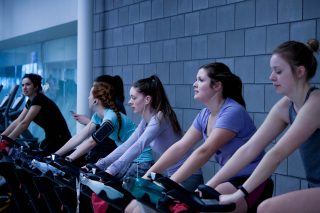Spinning is well known for being an exhilarating form of exercise. The classes are aimed at creating an atmosphere filled with vigor and excitement, promoting high-intensity workouts.
Where did the idea of spinning come from?
It was created and trademarked by South African-born Johnny Goldberg in 1989. Having broached the concept with fellow cyclists within the community, the concept of indoor cycling quickly caught on. Demand for its availability grew so high that by 1990 he was able to open up his own spin centre, and in 1995 the concept went global. The sport has a vast amount of health and lifestyle benefits. Spinning classes encompass a great amount of technique and planning, with dynamic music and motivated instructors. Each workout is goal-driven, encouraging perceptual strength and discipline.
Virgin Active Health Clubs offer a series of spinning classes every day, which they refer to as “Ride”. With their gyms being easily accessible and members having a wide variety of instructors, styles, and techniques to choose from, their sessions currently have an average of 250 000 visits every month. Spinning focuses on leg speed and resistance as a form of cardiovascular training. However, it is not as simple as getting onto an indoor bike and moving your legs. It requires a specific method of movement if you want to obtain the true benefits.

Photo by Trust “Tru” Katsande on Unsplash
How does it improve your fitness?
National group exercise manager at Virgin Active Health Clubs, Ignus Oosthuizen says: “How you do a workout properly whilst riding is crucial, and I think this is where quite a few members pick up that they are not working hard enough. It is of the utmost importance to coach and help members with their leg speed and resistance during an indoor cycling class, as it will help to them find their own individual effort and intensity levels.”
Your rate of perceived exertion is the personal level of how hard you are physically extending yourself at each given point during the workout, and it will differ for each individual.
He continues: “It is important for coaches to instruct members on what they need to feel while riding, as the bike itself cannot show you your own individual rate of perceived exertion. It is something you need to gauge as a person.”
Instructors achieve this through the use of music. This key component allows you to understand the intensity of your ride and how you should be feeling at any given point. The beat of the music tracks used will be the guided metronome of each class.
Did you know?
The faster the pace of the music, the higher the intensity of your leg speed, and the higher your rate of perceived exertion.
There are a number of extended physical benefits that come from spinning. Slightly straining your muscles as well as your cardiovascular and respiratory system during a workout allows you to gradually build your rate of perceived exertion, allowing for your overall fitness, health, and physical capabilities to increase. It can be beneficial to people with different lifestyles and health requirements, due to the versatility and adaptability of each class.
“You really get a broad range of people who participate in ride classes for various reasons, as it is such a good add-on to most workout regimens,” says Oosthuizen.
The majority of people like to use spinning as an additional form of exercise in their weekly workout, to improve overall fitness, but there are some who use it for more specific reasons. People who are in physical rehabilitation or maybe of a certain age often opt for spinning as it is a low-impact sport that does not cause any weight-bearing stress on the body. It is also a crucial supplement for professional athletes during their training, especially at the weekend. Spinning is not only a far safer option to riding on main roads but can be a dynamic way to train and build strength.



![women [longevity live]](https://longevitylive.com/wp-content/uploads/2020/01/photo-of-women-walking-down-the-street-1116984-100x100.jpg)









